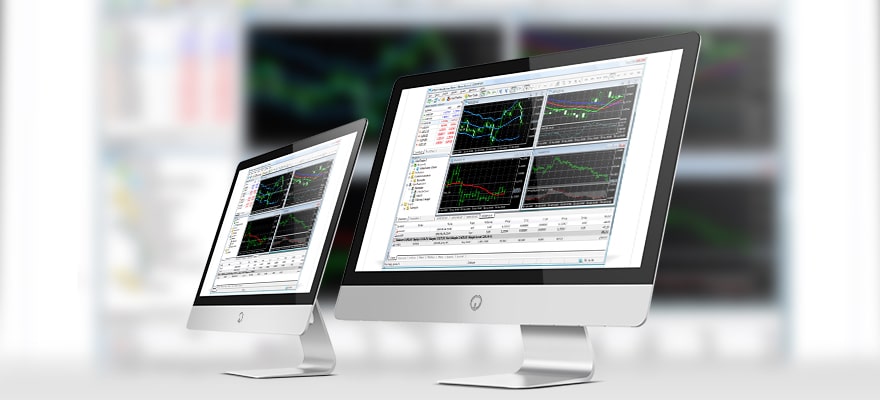itexsys Taps Your Bourse to Create MetaTrader 4 White Label Solution - Finance Magnates
itexsys Taps Your Bourse to Create MetaTrader 4 White Label Solution - Finance Magnates |
- itexsys Taps Your Bourse to Create MetaTrader 4 White Label Solution - Finance Magnates
- A Look at How to Trade Cryptocurrency on the MT4 Platform - Bitrates
- Forex Trading For Beginners: 6 Steps Every New Forex Trader Should Take - Benzinga
| itexsys Taps Your Bourse to Create MetaTrader 4 White Label Solution - Finance Magnates Posted: 30 Sep 2020 02:30 AM PDT  itexsys, a financial services technology company, announced this Wednesday that it has formed a strategic partnership with Your Bourse. Together, the two companies will prove a branded MetaTrader 4 white label solution to itexsys' broker clients. Under the agreement, brokers who sign up to itexsys' MetaTrader 4 white label through Your Bourse will be able to access what it calls the 'full Your Bourse technology package'. According to the statement, this includes a bridge, matching engine and liquidity aggregator. The Most Diverse Audience to Date at FMLS 2020 – Where Finance Meets Innovation Furthermore, users will be able to access real-time and historic reporting tools in addition to warehousing functionality. As time goes on, the financial services provider expects its partnership with Your Bourse to develop, which will result in more tools within the package at the same fixed price. itexsys Previously Exclusively Used Gold-i TechnologyUntil now, the financial technology provider has worked exclusively with Gold-i's technology to deliver its MetaTrader white labels. The collaboration announced today will see itexsys expand its offering by utilising the technology of Your Bourse. Suggested articlesPLUGIT Launches YOONIT V2.0Go to article >>  Source: LinkedIn Commenting on the partnership, Simon Blackledge, Founder and Director of itexsys, said in the statement: "As demand for our White Labels continues to rise, a key part of our expansion strategy was to find another high calibre technology provider so that we can provide a wider range of options to clients. Your Bourse is an ideal partner for us, a rapidly growing business with an evolving portfolio of products and a global reputation for excellence." Your Bourse Expects Significant Growth Opportunities from the PartnershipThe MetaTrader white label solutions are particularly of use for start-up and early stage brokers offering foreign exchange (forex) and contracts for difference (CFDs) trading that are not able to pay the upfront cost of a MetaTrader licence.  "We selected itexsys as our MetaTrader White Label partner as they are truly independent and are not aligned to any particular Liquidity Provider or brokerage," added Andrey Vedikhin, Founder and CEO of Your Bourse, in the statement. "They have a great reputation across the industry, and we believe this partnership will create significant growth opportunities for both our organisations." |
| A Look at How to Trade Cryptocurrency on the MT4 Platform - Bitrates Posted: 30 Sep 2020 04:55 AM PDT If you're new to the Forex market, this guide will walk you through how to trade cryptocurrency in MT4. What is cryptocurrency trading all about? The MetaTrader4 (MT4) trading platform is quite notable in the cryptocurrency and forex trading space. It offers advanced technical analysis, a flexible trading system, and algorithmic trading tools. For beginners, it's an ideal platform to start with because it is a convenient trading platform. With apps for Android, iOS, and PC, traders can trade using their preferred device. If you're new to the Forex market, this guide will walk you through on how to trade cryptocurrency in MT4. First of all, you should understand what cryptocurrency trading is all about. Cryptocurrency Trading OverviewNormally, people buy cryptocurrencies from exchanges, hold them in a wallet, and sell them off when they want. That's basic crypto trading and it often requires holding (or HODLING, as it is referred to by crypto enthusiasts), for a long time, anticipating the increase in value of the coin before selling. But, that's not what you'll be doing if you wish to trade on the MT4 platform. Instead, you'll be day trading which involves buying and selling crypto within a short period; ideally, less than 24 hours. Trading within such time requires careful thinking. The market is decentralized and relatively risky such that if you lose your money, there's no one to take responsibility but yourself. To avoid such, traders need to study the market, understand signals and use fast trading tools. That's where MetaTrader 4 comes in. How Reliable Is MT4?MT4 incorporates essential features that crypto day traders would need to make wins. Beginning with the trading system; you can launch any trading strategy, no matter how complex it might be. For instance, you can launch 3 execution modes, trailing stop, 2 market orders, 4 pending orders, and 2 stop orders. Moving to trading analytics - you need this to make informed trading decisions and MT4 presents it on a platter of gold. From the platform, you can access interactive charts, 23 analytical objects, 30 technical indicators, and 9 timeframes. When it comes to trading signals and copy trading, you can set trading options and allow the tool trade automatically. There are thousands of preset trading strategies, thousands of providers, and you can set any trading condition. Thankfully, MT4 has a built-in market. Here you can access the largest selection of trading applications across the globe and also access both commercial and free products. The market features over 100 trading indicators and over 700 trading robots. The last you should know is the MT4 algorithmic trading. You can develop automated trading programs to trade on your behalf using the MetaEditor and MQL4 language. Trading Cryptocurrencies on MT4As mentioned earlier, you'll be day trading with the MT4 platform and this will involve trading CFDs. Hence, you won't be needing a crypto exchange platform but instead a crypto broker platform. You may wonder what CFDs are all about. CFD stands for Contract For Difference, they are derivatives which give you the potential to trade on cryptocurrency price movements without actually purchasing the coins. This is very different from buying and selling crypto on exchanges. With CFDs trading, you can make profits whether the value of a cryptocurrency appreciates or depreciates, you just have to make the right speculation by going either long or short. If you go long, you speculate that the value of the coin will appreciate; hence, you buy. If you go short, you speculate that the value of the coin will depreciate; hence, you sell. Wrong speculation is synonymous with making a loss. That's how risky crypto trading can be. However, the risk can be managed and relatively lessened because CFD trading involves leverages and margins. Leverage allows you to control a large amount of money (trading position) with a small amount. For instance, a broker can set a leverage ratio at 100:1, giving you the chance to open a position of $50,000 and deposit just $500. Whatever profit the trade generates, you get 100% of it, if there's a loss, you lose 100% as well. As they say 'leverage is a 2-edged sword'. But, the advantage is that you won't risk the entire $50,000 from your pocket. Margin is simply the money you deposit to control a large position. From the previous example, a broker sets a leverage ratio at 100:1, giving you the chance to open a position of $50,000 and deposit just $500. The $500 you deposit is your trade margin. Usually, margins are expressed in percentages, relating to the leverage. A $50,000 trading position for $500 deposit means you're trading with a 1% margin hence the ratio. To trade cryptocurrencies on MT4, you first need to find a broker that offers advantageous leverages and margins. Of course, you also need to check if the broker features the MT4 trading platform but that shouldn't be a worry as almost all reliable crypto brokers feature it. However, most of the brokers you'll find are forex brokers who offer Cryptocurrency CFDs trading. There's nothing wrong with trading with such brokers but the most important thing is to ensure the broker is regulated. As a beginner trader, it is not advisable to rush into live trading on MT4. You first need to get acquainted with the environment, so you should first open a demo account. Majority of brokers offer this. When you're logged in on the platform:
Bottom LineAlthough the MT4 trading platform is very convenient, it is an advanced trading platform used by professional crypto traders. You can use it as a beginner but first, you should understand the crypto market. Not being knowledgeable on how the market works puts you at a great disadvantage and you have a higher chance of losing money than making it. As advised, practice using a demo MT4 account before going live. You can practice for weeks or even months, as long as it takes to get conversant. Disclaimer: information contained herein is provided without considering your personal circumstances, therefore should not be construed as financial advice, investment recommendation or an offer of, or solicitation for, any transactions in cryptocurrencies. |
| Forex Trading For Beginners: 6 Steps Every New Forex Trader Should Take - Benzinga Posted: 30 Sep 2020 07:23 AM PDT When I was 16 I decided I wanted to be a millionaire. I wasn't from a wealthy family, and I witnessed how my parents, especially my dad, struggled and worked hard to make ends meet. I knew I didn't want to walk down that road, so from this point on I continually studied and sought ways to make money. It eventually became clear to me that I had three primary means to get rich: own a business, invest, or combine the two. I discovered that I liked the idea of using money to make more money, and soon got fixated on investing. This was how I got introduced to forex trading. Unsurprisingly, I made a lot of mistakes early on. I blew out several trading accounts, with each loss leading to more pain and despair. However, there were also moments of victory. There were times when I would make more in hour trading than I would in a week at my job, all with a few clicks of the mouse. It was surreal. These were the feelings I clung to in my early days. It took me about 42 months to make my first windfall in forex trading. I was still a student at that point, trading in between classes and assignments. I remember feeling at the time that it seemed as if I'd been trading forever when in reality it had only been about three and a half years. Going forward, I carried on that momentum to build a trading business around my personal trading. People and companies started inviting me to give my insights at forex trading conferences around the world, and I had the honor of training traders at banks, fund management companies, and prop trading firms. In an effort to save others the time it took me, I've compiled a list of six forex trading strategies for beginners that embody everything I've learned over the last 20 years about how to trade forex and make money from it. Step 1: Learn How To Read Charts The price chart is one of the crucial things a forex trader must know and understand. I always find it funny when new traders go looking online for forex trading tutorials on trading strategies and then proceed to lose money when they try to implement them. Why does this happen? The simple answer is you have to learn to read the price chart! Trying to use someone else's trading strategy without being able to read the chart is like trying to do hurdles before you can walk. The reason for this is simple—no forex trading strategy works 100% of the time. If you rely solely on one trading plan to use at all times, it will eventually fail you. By learning how to read charts, specifically the forex price action and technical indicators like support, resistance, and trendlines, you will not only understand what is happening, but why. Step 2: Control Your Risk Trading is all about controlling your risk. Applying inappropriate risk is one of the primary reasons most forex beginners blow out their accounts when trading. For example, you should never be risking 100% of your account on a single trade. That's akin to gambling. As a general rule, most forex trading for beginner books will tell you to risk anywhere between 1-3% of your account per trade. But this low-risk strategy has drawbacks as well. If you have an account worth $1,000 and you risk 1% ($10) on a trade, you will have to make a lot of profitable trades to grow your account. This could lead you to overtrading, which could in turn increase your losses. Ultimately, you have to find the balance of risking enough to make the trade worth it, but not so much that your risk-reward ratio is too imbalanced. Step 3: Consider The Risk-Reward Ratio Too Every trade you enter should have a defined risk-reward ratio. That means knowing how much you are prepared to lose in addition to knowing how much you're prepared to make. In other words, have specific buy and sell targets on the upside and downside before you enter a trade. An account worth $1,000 with a 2% risk percent and a 1:2 risk-reward ratio would lose $20 on a losing trade but make $40 on a winning trade. The charts below show risk-reward ratios in practice. Step 4: Test The Effectiveness Of A Strategy Before You Use It There is a straightforward way to ascertain the effectiveness of a forex trading strategy. This process is called backtesting. Backtesting involves reviewing the results of trades made using a particular technique over a period. My general rule of thumb is I will consider a strategy if I observe a net profit for three consecutive years. I do my backtesting on the MetaTrader 4 trading platform, which allows you to backtrack to the period you wish to start testing from. Step 5: Watch Your Trade Entry Timing Let's paint a scenario. Imagine five forex traders, having trained under the same coach, spot the same setup. At the end of the trade, two of these traders make a profit while the other traders lost. What do you think could be the reason for the disparity in the result? They all spotted the same setup, so one would expect they would all have similar outcomes. The difference comes from their timing. Timing your entry is everything. A poorly timed entry can ruin a perfectly good setup. The two charts below show this concept in action. These scenarios highlight the importance of entry timing in forex trading. You should have it at the back of your mind never to chase a trade. If you miss your chance to enter, let the trade go and wait for the next. Step 6: Don't Get Emotional There is a concept in poker when a player gets too emotional after losing money and starts playing differently to win it back. This situation is known as tilt. While forex is a different ballgame entirely, the same concept applies. Understand that losing is an inherent part of trading. You should expect and prepare for it instead of getting vengeful. One way to keep your emotions in check is to never carry over the results of a previous trade into a new one. Treat every trade as if it's an entirely new entity and approach it with a clean mindset. If you find yourself carrying over positive or negative reactions from your previous trades, that's a recipe for clouded judgment. Another pro tip for controlling your emotions during trading: whenever you feel agitated or emotionally-charged, take a break. Stop trading until you have regained your composure. Conclusion I hope the above tips help you the way they have helped me. Forex trading is a great way to make money but as a beginner but it's also a great way to lose money if you're not careful. By understanding charts, having a forex trading strategy that works, and controlling your risk and emotions, you're setting yourself up for long-term success. Ezekiel Chew founded Asia Forex Mentor in 2008 with the sole purpose of teaching R.O.I-based trading backed by mathematical probability. To learn more about his system check out the Asia Forex Mentor One Core Program. © 2020 Benzinga.com. Benzinga does not provide investment advice. All rights reserved. |
| You are subscribed to email updates from "metatrader 4" - Google News. To stop receiving these emails, you may unsubscribe now. | Email delivery powered by Google |
| Google, 1600 Amphitheatre Parkway, Mountain View, CA 94043, United States | |
Comments
Post a Comment